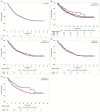Investigation of racial differences in survival from non-small cell lung cancer with immunotherapy use: A Texas study
- PMID: 36698397
- PMCID: PMC9869031
- DOI: 10.3389/fonc.2022.1092355
Investigation of racial differences in survival from non-small cell lung cancer with immunotherapy use: A Texas study
Abstract
Background: The use of immunotherapy is associated with improved survival among patients with Non-Small Cell Lung Cancer (NSCLC) and has gained widespread use in its management. However, there is limited information on whether the survival benefits associated with immunotherapy differ among races and ethnicities.
Objective: This study aimed to investigate racial differences in survival amongst patients with NSCLC who received immunotherapy as the first-line treatment in Texas.
Methods: Patients with NSCLC who received immunotherapy between October 2015 to December 2018 were identified from the Texas Cancer Registry (TCR). Disease-specific survival was evaluated and compared among patients across racial/ethnic categories using the Kaplan-Meier survival analysis, log-rank test, and a multivariable Cox proportional hazard regression model following an inverse probability treatment weighting (IPTW) propensity score analysis.
Results: A total of 1453 patients were included in the analysis. Median survival (in months) was longest among Asians (34, 95% CI: 15-Not Estimable), followed by African Americans (AAs) (23, 95% CI: 15-34), Hispanics (22, 95% CI: 16-26), and Whites (19, 95% CI: 17-22). The adjusted regression estimates had no statistically significant differences in survival among AAs (aHR = 0.97; 95% CI = 0.78-1.20; P =0.77) and Hispanics (aHR = 0.96; 95% CI = 0.77-1.19, P =0.73) when compared to White patients. Asians on the other hand, had 40% reduction in mortality risk compared to Whites (aHR = 0.60; 95% CI = 0.39-0.94, P = 0.03).
Conclusions: Our study indicated that African Americans and Hispanics do not have poorer survival compared to White patients when receiving immunotherapy as first-line treatment. Asians however had longer survival compared to Whites. Our findings suggest that existing racial disparity in NSCLC survival might be mitigated with the use of immunotherapy and should be considered in providing care to these minority groups.
Keywords: immunotherapy; non-small cell lung cancer; racial disparity; retrospective study; survival analysis.
Copyright © 2023 Olateju, Zeng, Adenaiye, Varisco, Zakeri and Sujit.
Conflict of interest statement
The authors declare that the research was conducted in the absence of any commercial or financial relationships that could be construed as a potential conflict of interest.
Figures





Similar articles
-
Disparities in Survival Outcomes Among Patients With Metastatic Melanoma in Texas: Implications for Policy and Interventions in the Era of Immune Checkpoint Inhibitors.Am J Clin Oncol. 2024 Nov 1;47(11):517-525. doi: 10.1097/COC.0000000000001128. Epub 2024 Jun 28. Am J Clin Oncol. 2024. PMID: 38937888
-
Hispanics/Latinos in the Bronx Have Improved Survival in Non-Small Cell Lung Cancer Compared with Non-Hispanic Whites.J Racial Ethn Health Disparities. 2020 Apr;7(2):316-326. doi: 10.1007/s40615-019-00660-2. Epub 2019 Nov 11. J Racial Ethn Health Disparities. 2020. PMID: 31713221 Free PMC article.
-
Impact of Race on Treatment and Survival among U.S. Veterans with Early-Stage Lung Cancer.J Thorac Oncol. 2016 Oct;11(10):1672-81. doi: 10.1016/j.jtho.2016.05.030. Epub 2016 Jun 11. J Thorac Oncol. 2016. PMID: 27296104
-
Surveillance mammography use after treatment of primary breast cancer and racial disparities in survival.Med Oncol. 2013 Dec;30(4):691. doi: 10.1007/s12032-013-0691-8. Epub 2013 Aug 22. Med Oncol. 2013. PMID: 23975632
-
The prevalence, burden, and treatment of severe, frequent, and migraine headaches in US minority populations: statistics from National Survey studies.Headache. 2015 Feb;55(2):214-28. doi: 10.1111/head.12506. Epub 2015 Feb 3. Headache. 2015. PMID: 25644596 Review.
Cited by
-
Gene expression-based modeling of overall survival in Black or African American patients with lung adenocarcinoma.Front Immunol. 2024 Nov 11;15:1478491. doi: 10.3389/fimmu.2024.1478491. eCollection 2024. Front Immunol. 2024. PMID: 39588372 Free PMC article.
-
Molecular Pathway and Immune Profile Analysis of IPMN-Derived Versus PanIN-Derived Pancreatic Ductal Adenocarcinomas.Int J Mol Sci. 2024 Dec 7;25(23):13164. doi: 10.3390/ijms252313164. Int J Mol Sci. 2024. PMID: 39684873 Free PMC article.
-
Computational immunogenomic approaches to predict response to cancer immunotherapies.Nat Rev Clin Oncol. 2024 Jan;21(1):28-46. doi: 10.1038/s41571-023-00830-6. Epub 2023 Oct 31. Nat Rev Clin Oncol. 2024. PMID: 37907723 Review.
References
-
- Zhou K, Shi H, Chen R, Cochuyt JJ, Hodge DO, Manochakian R, et al. . Association of race, socioeconomic factors, and treatment characteristics with overall survival in patients with limited-stage small cell lung cancer. JAMA Netw Open (2021) 4:e2032276. doi: 10.1001/JAMANETWORKOPEN.2020.32276 - DOI - PMC - PubMed
-
- Raphael J, Batra A, Boldt G, Shah PS, Blanchette P, Rodrigues G. Predictors of survival benefit from immune checkpoint inhibitors in patients with advanced non-small-cell lung cancer: A systematic review and meta-analysis. Clin Lung Cancer (2020) 21:106–113.e5. doi: 10.1016/J.CLLC.2019.11.004 - DOI - PubMed
-
- Lung Cancer Statistics . How common is lung cancer? Available at: https://www.cancer.org/cancer/lung-cancer/about/key-statistics.html (Accessed March 17, 2022).
LinkOut - more resources
Full Text Sources

